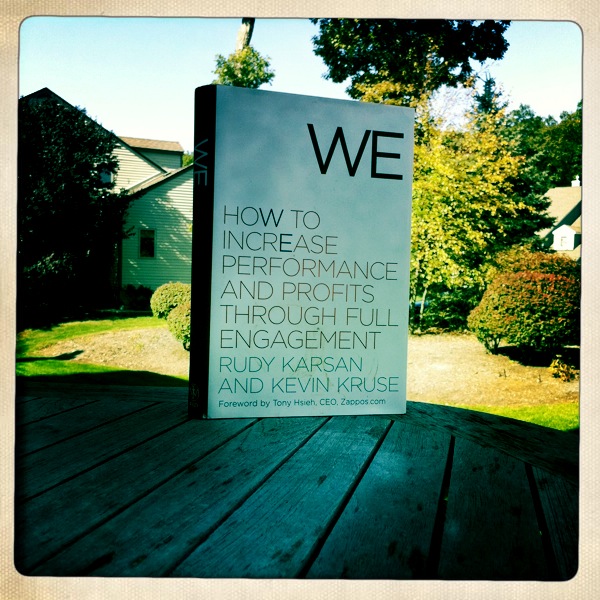Books We Trust: We: Performance, Profit and Full Engagement
This is the sixth in a series called Books We Trust.
In this issue, we talk with Kevin Kruse about his book with Rudy Karsan entitled We: How to Increase Performance and Profits Through Full Engagement.
Kevin is a serial entrepreneur, founder of The Kruse Group, and co-founder of the e-Patient Connections conference. His co-author Rudy Karsan is founder and CEO of Kenexa, a leading firm in global HR solutions.
Another Engagement Book?
Trusted Advisor Associates: Kevin, I confess to some skepticism when I first met the book. Besides being the hands-down winner of the shortest-book-title award, I thought of engagement as being something of a statistical correlation—certainly true, but hard to pin down and make manageable and irrelevant.
I no longer think that. The simple indicator of whether people see themselves as “we” rather than “they” in the workplace hints at huge implications. What’s at stake with engagement?
Kevin Kruse: More is at stake than most people realize. Research shows that people who are dissatisfied at work weigh on average five pounds more than those who are satisfied. Dissatisfied workers are twice as likely to die from a heart attack, they have less sex in their marriage and even their kids are more likely to misbehave. This is because our emotions at work spill over to all other areas of our life and even cross over to those around us.
And for business, there are now numerous studies that show that engagement correlates strongly to faster growth, higher profits and better shareholder returns.
TAA: One of the impacts on me is that I will never talk about “work-life balance” again; the real issue is work-life integration. This is not some 21st-century Utopian view we’re talking about here—it’s always been the case, hasn’t it?
Kevin: That’s right. A lot of my friends in HR don’t like to hear me say it, but the whole work-life balance movement is destined to fail. It cannot succeed because we’ve never had it.
Through the course of human history we’ve always just lived, and spent whatever time we needed to “produce.” First we ate what we killed, then ate what we harvested. Even when we developed skills and lived in villages we often lived and worked in the same building. If I happened to be an iron smith, my name would have been Kevin the Smith and I’d work whenever someone showed up to buy some armor or sharpen their sword.
Then a funny thing happened called the Industrial Revolution. For the first time, after 50,000 years, we suddenly left our families and villages and moved to cities where we were paid for our time. Suddenly our work became separate from our identity, separate from our home, and we began to view it as separate from ourselves. We worked from 9 to 5, and there’s that song, “Working for the Weekend.”
But psychologists have shown that we can’t bottle up our thoughts and emotions at 5:00pm—they come home with us. We can’t and shouldn’t fight it. The global economy is forcing most of us to work on virtual teams with multiple time zones.
We’re living longer than ever before and with retirement safety nets shrinking we need to work longer and longer. This requires a change in our thinking. We need to strive for a work-life blend, and strive to enjoy what we do—to be engaged on a daily basis.
TAA: You’re quite familiar with the work Gallup did defining engagement some years ago, but rather than a complex statistical definition of the phenomenon “engagement,” you focus on a much simpler (four subjects) and more personal-based definition.
How did you come to define engagement as Pride + Satisfaction + Advocacy + Retention?
Kevin: Indeed there are literally hundreds of definitions out there for “employee engagement.” My co-author, Rudy Karsan, is the founder of Kenexa—one of the world’s largest employee survey companies—so we used their measure.
Their approach is that engagement is not some nebulous thing—it can actually be measured. Engaged employees exhibit greater pride in their company and satisfaction in their job; they become advocates who tell their friends about job openings and brag about their product launches, and of course they are less likely to leave for another opportunity. These are four things that can all be measured through a survey process.
Linking Engagement to the World
TAA: Another surprise was how widely-researched the book is: links to photographic essays of jobs that no longer exist, time-series about pay structures, cross-cultural examples of the relevance of work to life.
Did you start with engagement and work your way out? Or did the impetus come from something broader?
Kevin: The idea was to focus on engagement, but the research led me in entirely new directions. I was surprised to learn about the huge impact engagement has on our health and relationships outside of work. I was surprised to learn that the proportion of compensation tied to variable pay has tripled in the last 20 years, from 4.2% in 1990 to 12% in 2009. What started as a business book just for managers became a call to arms for all modern workers to get engaged.
TAA: You quote Lou Gerstner, “Culture is everything.” If culture is everything, and if you do or don’t fit with a given culture, then you are or are not engaged. And that turns out to make huge differences in a person’s life.
I hadn’t seen this argument made so tightly before—would you care to say more about it?
Kevin: I have three small kids right now and I always hear people ask them, “What do you want to be when you grow up?” But I think another question, maybe even a more important question is, “Where do you want to be when you grow up?” After all, maybe you’re someone who has truly found your passion, and it happens to be computer programming.
That’s great. But working at Google in California is very different than working at IBM in New York state. So you have the same industry, but different cultures, that are reflected in office environment, dress code, communication style, career advancement and on and on. People seem to spend all their time figuring out the “what,” when we should also be considering the “where.”
Engagement: the Employer Side
TAA: Tell us why employers should care whether you’re engaged? Tony Hsieh of Zappos—probably the popular press’s poster child for engagement—wrote the forward to your book; why does he care?
Kevin: Tony knows that engaged employees lead to engaged, repeat customers. Another great CEO, Doug Conant of Campbell Soup, had two primary measures that he constantly focused on: shareholder return and employee engagement.
These CEOs know that employee engagement is the first step in the “Service Profit Chain.” Engagement drives productivity, quality, and service, which in turn drives customer satisfaction, which in turn drives growth and profit, which in turn drives stock price. The Kenexa study on this issue showed that the total shareholder return of engaged companies is five times higher than companies with disengaged workers.
Driving Engagement: the GR8 Model
TAA: You boiled down a ton of research, again, to a fairly straightforward conclusion: the three drivers of employee engagement are growth, recognition, and trust (neatly acronymized as GReaT, or just GR8 for short). Tell us about that.
Kevin: Well, engagement is based on the individual, of course, and in the book we identify eight total drivers of engagement. But based on the research and our own experience as entrepreneurs we boiled it down to the top three, as you say. A feeling of growth can come from advancing up the ranks of a company, but more important is the sense that you’re growing as an individual; you are learning new things.
Recognition isn’t really about the bonus check or annual awards dinner, it’s more about feeling appreciated on a daily basis. It means you are being thanked, and that your ideas count.
Last, and probably most important is Trust, which of course you know more about than I do! But our research indicates that trust works on two levels. We need to believe that our leaders are honest and ethical, but also we need to trust that they’ll get us to a better place in the future. It’s about knowing what the future vision is and trusting that our leaders are going to successfully guide us there.
TAA: You’ve written a really practitioner-friendly book. You have chapters available online as .pdfs, online worksheets, and to top it off some of Kenexa’s tools fit beautifully into the narrative—they’re not bolted on at all. How should people use this book?
Kevin: Thanks, Charlie, that was something I worked hard at. Personally, I love books. So in this time of YouTube and iPads I wanted to actually create an interactive experience. The good news is that we’ve made most of the content accessible, even if you don’t buy the book. Anybody interested in engagement can just go to www.WeTheBook.com and you can download free chapters, access online quizzes, and see special video summaries, too.
TAA: Kevin, this is a gem of a book. Not only should employers read it, I’d suggest anyone who is or will ever be an employee will benefit from it. Thanks for taking the time with us to talk about it.
Kevin: My pleasure.



Leave a Reply
Want to join the discussion?Feel free to contribute!